![]()
![]()
![]()
Use LEFT and RIGHT arrow keys to navigate between flashcards;
Use UP and DOWN arrow keys to flip the card;
H to show hint;
A reads text to speech;
12 Cards in this Set
- Front
- Back

Tsuga canadensis Pendual
|
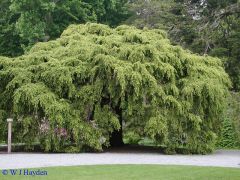
Weeping Canadian Hemlock
Latin name : Tsuga canadensis Pendula Common Name: Canadian hemlock Zone: 3 to 7 Plant Type: Needled evergreen Family: Pinaceae Missouri Native: No Native Range: None Height: 4 to 5 feet Spread: 8 to 10 feet Bloom Time: Non-flowering Bloom Data Bloom Color: Non-flowering Sun: Part shade to full shade Water: Medium Maintenance: Low |
|
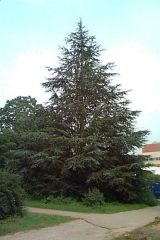
Cedrus atlantica 'Glauca'
|

Blue Atlas Cedar
Habitat • native to Atlas Mountains of northwestern Africa • zone 6, protected parts of 5 Habit and Form • evergreen needle conifer • medium-sized tree, 40' to 60' tall • in optimum conditions can reach up to 100' tall and 40' wide • pyramidal when young, flat-topped and spreading when mature • has stiff, horizontal main branching; branching somewhat sparse, especially when young • very interesting and picturesque habit as a mature tree Summer Foliage • needles 0.5" to 1" long, slightly curved • color varies from green to silvery-blue • needles arranged spirally on long shoots and in rosettes on short spur growth • new shoots are downy Autumn Foliage • evergreen Flowers • monoecious male and female cones on same tree • male cones 2" to 3" long, numerous and primarily on lower part of the tree • male flowers shed pollen in fall • female flowers are upright and purplish • female flowers mostly in the upper parts of a plant Fruit • cones borne upright along branches • 3" long, rather fat, barrel-shaped • cones take two-years to mature Bark • gray and smooth for 20 - 30 years • eventually developing a plate-like pattern Culture • prefers moist, deep soils, but tolerant of dry, sandy soils • full sun is best • tolerant of pollution, urban conditions • difficult to transplant; best as container grown • needs protection from sweeping winds • will get considerable needle burn and injury during cold winters and when sited poorly in windy locations. Severely winterburned trees generally recover well if established |
|
|
Pseudotsuga menziesii
|
Douglas Fir
Habitat • native to western North America • both in Rocky Mountains and coastal regions • zone 4 Habit and Form • a large evergreen tree • coniferous • in its native haunts it grows to 150' tall or more • landscape trees reach 60' to 80' tall with 15' to 20' spread • conical shape • horizontal branches with pendulous branchlets Summer Foliage • leaves are evergreen needles, 1" to 1.5" ling • leaves are spirally-arranged or 2-ranked • color varies from blue-green to gray-green or shiny, bright green Autumn Foliage • no fall color (evergreen) • some annual drop of old needles occurs • winter buds are long-pointed and dark brown Flowers • no ornamental value • flowers are monoecious • male flowers are axillary and pendulous • female flowers are terminal Fruit • tan cones, 3" to 4" long • conspicuous 3-pointed bract project from between cone scales • bracts look like a snake's tongue Bark • mature trunks have bark with reddish brown ridges and irregular fissures • bark on young trunks is smooth with resin blisters |
|
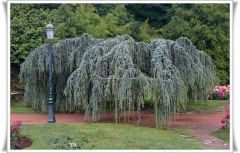
Cedrus atlantica 'Glauca Pendula'
|

Weeping Blue Atlas Cedar<br><br>Description<br>Atlas cedar is a large and majestic evergreen conifer that can get as tall as 120 ft (36.6 m) and have a spread of 100 ft (30.5 m). More commonly, and especially in the US, it grows 40-60 ft (12-18 m) tall and 20-40 ft (6-12 m) wide. This cedar is neatly cone shaped in youth, becoming more open and spreading with a flat top as it ages. The bark is silvery gray and fissured. The stiff, needlelike leaves are bluish green, less than 1 in (2.5 cm) long, and clustered in tufts on short lateral spurs. The egg shaped cones are 3 in (7.6 cm) long, green while developing and brown when mature. When ripe they shatter to release papery winged seeds.<br>Selections include 'Aurea' with yellowish needles, 'Glauca' with silvery blue foliage, and 'Glauca Pendula', a bizarre clone with no central leader and drooping and spreading branches that require staking and training.<br><br>Location<br>Atlas cedar is native to the Atlas Mountains of Morocco and Algeria in northern Africa.<br><br>Culture<br>Atlas cedar does well in sandy to clayey, and acidic to alkaline soils. It grows fast and upward for the first 10-20 years, then as the central leader loses dominance, growth slows and the crown spreads. In young trees, lateral branches may have to be pruned back to keep them from breaking under their own weight. Never prune the central leader though, lest the tree's beautiful form be destroyed. <br>Light: Full sun or partial shade.<br>Moisture: Drought tolerant once established.<br>Hardiness: USDA Zones 6 - 9. The cultivar 'Glauca Pendula' is perhaps somewhat hardier - Jack grew this shrubby version of Atlas cedar in Cincinnati, Ohio which is in Zone 5. <br>Propagation: Atlas cedar is usually grown from seed. Cultivars are grafted onto seedlings of the species.
|
|
|
Sciadopitys verticillata
|
Japanese Umbrella Pine
Habitat • native to Japan • zone 5, possibly 4 Habit and Form • evergreen, coniferous, small to medium-sized tree • dense and compact when young • becomes more open and loose with age conical shape overall • can vary from broadly pyramidal to almost spire-like • many trees have multiple-trunks • slow-growing, but long lived • 25' to 40' tall and 15 to 20' wide Summer Foliage • leaves are evergreen • leaves are of 2 kinds • large linear leaves are in terminal whorls of 20 to 30 • large leaves are 2" to 5" long and somewhat flattened • small scale-like leaves are distributed around the shoot below each whorl of needles • large needles are dark green and glossy • needles persist 3 years Autumn Foliage • evergreen, so no fall color Flowers • monoecious with male and female flowers • female flowers are solitary at the ends of branches • male flowers are in 1" terminal clusters that are readily visible in spring Fruit • 2" to 4" long cones, about 1" to 2" wide • cone scales are thick and chunky-looking • green cones turn brown at maturity • young trees rarely fruit Bark • reddish-brown, exfoliating in shreds or strips • quite attractive, but generally hidden from view by the dense foliage Culture • rich, moist acidic soils are best • avoid difficult sites with sweeping winter winds • full sun is required |
|
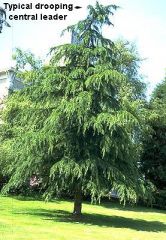
Cedrus deodara
|

Deodara Cedar
With its pyramidal shape, soft grayish-green (or blue) needles and drooping branches, this cedar makes a graceful specimen or accent tree (Fig. 1). Growing rapidly to 40 to 50 feet tall and 20 to 30 feet wide, it also works well as a soft screen. The trunk stays fairly straight with lateral branches nearly horizontal and drooping. Lower branches should be left on the tree so the true form of the tree can show. Allow plenty of room for these to spread. They are best located as a lawn specimen away from walks, streets, and sidewalks so branches will not have to be pruned. Large specimens have trunks almost three feet in diameter and spread to 50 feet across. GENERAL INFORMATION Scientific name: Cedrus deodara Pronunciation: SEE-drus dee-oh-DAR-uh Common name(s): Deodar Cedar Family: Pinaceae USDA hardiness zones: 7 through 9A (Fig. 2) Origin: not native to North America Uses: wide tree lawns (>6 feet wide); recommended for buffer strips around parking lots or for median strip plantings in the highway; screen; specimen; residential street tree Availability: generally available in many areas within its hardiness range DESCRIPTION Height: 40 to 60 feet Spread: 20 to 30 feet Crown uniformity: symmetrical canopy with a regular (or smooth) outline, and individuals have more |
|
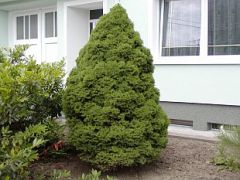
Picea pungens Glauca Group
|

Blue Colorado Spruce
Habitat • native to Japan • zone 5, possibly 4 Habit and Form • evergreen, coniferous, small to medium-sized tree • dense and compact when young • becomes more open and loose with age conical shape overall • can vary from broadly pyramidal to almost spire-like • many trees have multiple-trunks • slow-growing, but long lived • 25' to 40' tall and 15 to 20' wide Summer Foliage • leaves are evergreen • leaves are of 2 kinds • large linear leaves are in terminal whorls of 20 to 30 • large leaves are 2" to 5" long and somewhat flattened • small scale-like leaves are distributed around the shoot below each whorl of needles • large needles are dark green and glossy • needles persist 3 years Autumn Foliage • evergreen, so no fall color Flowers • monoecious with male and female flowers • female flowers are solitary at the ends of branches • male flowers are in 1" terminal clusters that are readily visible in spring Fruit • 2" to 4" long cones, about 1" to 2" wide • cone scales are thick and chunky-looking • green cones turn brown at maturity • young trees rarely fruit Bark • reddish-brown, exfoliating in shreds or strips • quite attractive, but generally hidden from view by the dense foliage |
|
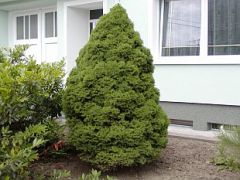
Picea glauca 'Conica'
|

Dwarf Alberta Spruce
• Form o medium-sized evergreen specimen shrub o to 10' tall by 3' wide and occasionally larger, but often smaller o upright pyramidal growth habit o very slow growth rate • Culture o full sun to partial sun o best performance occurs in full sun in a moist, well-drained soil, sited a few feet away from any other hardscape structure, plant, or artificial irrigation, so that airflow and sunshine will remove moisture from the very dense foliage o not tolerant of urban stresses (especially to pollution, Winter salt spray, continuously dry soils, high light reflection, and heat) to which it is often exposed o propagated by rooted stem cuttings o Pine Family, with a few serious pest (and possibly also disease) problems that, when coupled with the overplanting of this formal shrub, serve to render it as an eventual liability in the landscape o abundantly available in container form o insects (especially mites) will infest the plant sooner or later, especially in areas of the shrub that are more prone to repeated Spring and Summer wetness (such as the backside of the shrub next to a wall or foundation after a rain, the bottom one-third above the morning dew, or the lawn side next to an irrigation system); infestations will lead to localized stem and needle death, which will make the plant very unsightly; for this reason, Dwarf Alberta Spruce should only be used with discretion in areas with good air circulation and possibly with an annual pesticide preventive application program o reversion to the species form will rarely occur as a prominent shoot with thicker stems and much larger foliage; this should be pruned away at just below the point of origination, as it will predominate that section of the shrub and alter its formal appearance • Foliage o medium- to light-green, very thin, densely packed needles are up to 0.5" long, radiating around the thin stems • Flowers o virtually non-existent, and ornamentally insignificant • Fruits o rarely has very small cones • Twigs o light brown and very thin • Trunk o thin brown-gray scales with age, hidden by the branching and foliage to the ground • ID Summary o usually a medium-sized shrub having a very formal, pyramidal outline, of very slow growth rate, with small medium-green needles on the densely branched thin stems, eventually maturing at about 10' in height and 3' in width, with individual branches becoming slightly mounded in the more conical outline of the mature shrub USAGE |
|
|
Picea orientalis
|
Oriental Spruce
Habitat • native to Asia Minor • zone 4 Habit and Form • evergreen tree with horizontal, pendulous branches • narrow, compact, conical shape • 50' to 60' tall , can reach 120' • slow growth rate • medium texture Summer Foliage • needles are 4-sided with a blunt tip • 1 to 4 stomatal lines on each side • needles are 0.25" to 0.50" long • shortest needles of all spruces • dark green color Autumn Foliage • no fall color, evergreen Flowers • monoecious • not ornamentally important Fruit • cones are on short stalks found at the ends of branches • mature cones are cylindrical; 2" to 4" long by 1" wide • reddish purple color turning to a medium brown at maturity • cone scales have smooth margins Bark • medium brown color • peeling, thin scales Culture • adaptable to many soil types as long as they are moist • can not tolerate harsh winters • full sun Landscape Use • specimen • screen • large shade tree when an evergreen is desired |
|
|
Picea ormorika
|
Serbian Spruce
Hardiness Zones: 4-7 Habit: Evergreen Growth Rate: Slow Site Requirements: Sun to partial shade; moderately moist, well drained soil but will grow in sand and heavy clay Texture: Medium Form: Slender trunk; short ascending branches; narrow pyramidal habit Height: 50 to 60’ Width: 15 to 25’ Leaf: .5 to 1" overlapping flat needles; glossy dark green above with 2 white lines on lower side (silvery underside); sharp pointed Flower/Fruit: Nonshowy purple flowers; 1.2 to 2" cones; blue black when young, cinnamon brown with age Comments: One of the most attractive and adoptable spruces; prefers a dry atmosphere and protection from wind; bark scales off in plates |
|
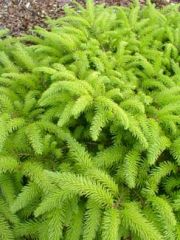
Picea abies Dwarf Group
|

Dwarf Norway (Birds Nest) Spruce
Characteristics Cultivar: Nidiformis Family: Pinaceae Size: Height: 3 ft. to 5 ft. Width: 10 ft. to 12 ft. Plant Category: shrubs, Plant Characteristics: low maintenance, spreading, Foliage Characteristics: evergreen, Foliage Color: dark green, Flower Characteristics: fragrant, Flower Color: Tolerances: deer, pollution, rabbits, slope, wind, Requirements Bloomtime Range: not applicable USDA Hardiness Zone: 3 to 8 AHS Heat Zone: 2 to 7 Light Range: Part Sun to Full Sun pH Range: 4.5 to 6.5 Soil Range: Some Sand to Clay Loam Water Range: Normal to Moist his fast growing evergreen tree is extremely hardy and wind resistant. Pyramidal growth habit when young, becoming columnar when mature. Bark is red-brown. Leaves are needle-like, dark green, blunt, and four sided, to 1 inch long. Leaves point upward and forward on orange-brown shoots. Female cones are deep green and conical, turning brown later in the year, 4 to 8 inches long. Norway is the most commonly cultivated spruce. Many dwarf and slow growing cultivars are available. 'Nidiformis' is a slow-growing, spreading, bushy shrub with an open "nest' in the center. |
|
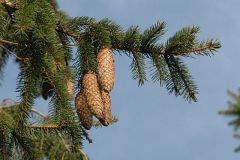
Picea abies
|

Norway Spruce
Habitat • native to northern and central Europe • zone 3 Habit and Form • evergreen tree with horizontal branches and pendulous branchlets • conical in shape • 40' to 60' tall and 35' to 30' wide • fast growth rate when young, slows down with age • fairly dense when young, becoming a bit more open with age • medium texture Summer Foliage • needles that persist for 3 to 4 years • needles are stiff and pointed, 0.5" to 1" long • needles tend to point downwards and towards the stem tip • medium green in color Autumn Foliage • no fall color, evergreen Flowers • monoecious • female flowers are terminal and are pink in color Fruit • cones found at the ends of branches • mature cones are long and narrow; 4" to 6" long by 1.5" to 2" wide • light green color turning to a medium brown at maturity Bark • gray brown color • peeling, thin scales Culture • large trees transplant easily • best in well-drained, sandy soils • prefers acidic soils • prefers cooler climates • full sun Landscape Use • needs room to develop • windbreak • screen • large shade tree when an evergreen is desired |

